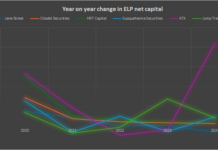Market participants report the current proposals by the US Securities and Exchange Commission (SEC) to centrally clear trades in the US Treasuries market are soon to be published.
Market making in the US Treasuries market has been declining for ten years, and vanished completely in March 2020, albeit temporarily. In part that was reported to be driven by the growth of proprietary trading firms which make up the majority of the volume in the interdealer market, but deny they are dealers.
Sell-side traders have reported the impact of these firms as preying upon dealer order flow, arbitraging pricing gaps between cash and futures markets, which affects the cost of trading for sell-side firms.
“There is an issue with the futures market because in fixed income the two-year, five-year and 10-year cash instruments move in line with the futures,” noted one trader speaking in 2014. “It is not just a case of front-running as in the equity market. There are also the same things being traded on different exchanges. People who are co-located will see orders going through in the futures market and lift people in the cash. Then they get left with a basis trade [using a price discrepancy arbitrage] where they have got one or two ticks onside which is extremely valuable on a basis trade.”
The last ten years have seen three hitherto unprecedented events involving sudden liquidity and pricing crises.
A ‘flash crash’ in US treasuries on 15 October 2014 saw the 10-year treasury rate fall 34 basis points over a 10-minute period from 2.2% to 1.86%, a 52-week low, before rebounding for the end of day, as prices spiked.
Repo markets saw a flash spike in interest rates which quadrupled during the working day on 17 September 2019.
Then in March 2020 liquidity dried up to such an extent that Michael Fleming, head of Capital Markets Studies in the Federal Reserve Bank of New York’s Research and Statistics Group, found that price impact for a trade was comparable to levels last seen in the 2007-09 financial crisis.
Liquidity, it was argued, was being provided on a shallow basis by high-frequency trading (HFT) proprietary trading firms, while hedge funds were creating sudden liquidity pressure when they had to unwind leveraged directional trades. In combination this created systemic risk.
In 2022, announcing newly-proposed capital rules, SEC chair Gary Gensler tied these events to proprietary trading firms, saying “In recent years, we’ve seen a number of high-profile events in markets with significant participation by PTFs. Tremors in the Treasuries markets in 2014, 2019, and at the beginning of the COVID crisis in 2020 demonstrate the importance of the SEC’s oversight of dealers, consistent with the statute.”
Central clearing is expected to allow traditional market makers to have access to more capital through centralised netting of positions via a central counterparty, while also reducing the risk created by leverage. Again, this will reduce pressure on traditional market makers.
“Clearing in general is a good thing and can work,” says Kevin McPartland, head of market structure and technology research at Coalition Greenwich. “The challenge is that the market has been operating the way it has for a very long time. Creating infrastructure will come at a big cost to the industry. And so we really have to take into account, is that worth the potential benefits. It is very different to the Dodd Frank implementation with swaps where you were managing 30 year counterparty exposures; Treasuries settle T+1, so the counterparty risk is very different. There are benefits, don’t get me wrong, but they are not as big or obvious.”
According to a recent paper by Nate Wuerffel, head of market structure at BNY Mellon, structural concerns around the US Treasury market, the imminent announcement is something that firms ought to prepare for.
“The SEC’s aim is to bolster the market’s resilience through improved default management processes, smaller settlement flows and reduced settlement fails. Central clearing will strengthen the market’s core attributes of safety and liquidity in times of stress. But implementation will be difficult and will reassemble the way the Treasury market functions at a time of heightened volatility. The rule is likely to be finalised soon, and the implementation timeline may be shorter than expected. Market participants would do well to prepare.”
©Markets Media Europe 2023
©Markets Media Europe 2025













